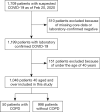Clinical characteristics of COVID-19 infection in chronic obstructive pulmonary disease: a multicenter, retrospective, observational study
- PMID: 32642086
- PMCID: PMC7330323
- DOI: 10.21037/jtd-20-1914
Clinical characteristics of COVID-19 infection in chronic obstructive pulmonary disease: a multicenter, retrospective, observational study
Abstract
Background: Coronavirus disease 2019 (COVID-19) has been a global pandemic disease, with more than 4 million cases and nearly 300,000 deaths. Little is known about COVID-19 in patients with chronic obstructive pulmonary disease (COPD). We aimed to evaluate the influence of preexisting COPD on the progress and outcomes of COVID-19.
Methods: This was a multicenter, retrospective, observational study. We enrolled 1,048 patients aged 40 years and above, including 50 patients with COPD and 998 patients without COPD, and with COVID-19 confirmed via high-throughput sequencing or real-time reverse transcription-polymerase chain reaction, between December 11, 2019 and February 20, 2020. We collected data of demographics, pathologic test results, radiologic imaging, and treatments. The primary outcomes were composite endpoints determined by admission to an intensive care unit, the use of mechanical ventilation, or death.
Results: Compared with patients who had COVID-19 but not COPD, those with COPD had higher rates of fatigue (56.0% vs. 40.2%), dyspnea (66.0% vs. 26.3%), diarrhea (16.0% vs. 3.6%), and unconsciousness (8.0% vs. 1.7%) and a significantly higher proportion of increased activated partial thromboplastin time (23.5% vs. 5.2%) and D-dimer (65.9% vs. 29.3%), as well as ground-glass opacities (77.6% vs. 60.3%), local patchy shadowing (61.2% vs. 41.4%), and interstitial abnormalities (51.0% vs. 19.8%) on chest computed tomography. Patients with COPD were more likely to develop bacterial or fungal coinfection (20.0% vs. 5.9%), acute respiratory distress syndrome (ARDS) (20.0% vs. 7.3%), septic shock (14.0% vs. 2.3%), or acute renal failure (12.0% vs. 1.3%). Patients with COPD and COVID-19 had a higher risk of reaching the composite endpoints [hazard ratio (HR): 2.17, 95% confidence interval (CI): 1.40-3.38; P=0.001] or death (HR: 2.28, 95% CI: 1.15-4.51; P=0.019), after adjustment.
Conclusions: In this study, patients with COPD who developed COVID-19 showed a higher risk of admission to the intensive care unit, mechanical ventilation, or death.
Keywords: Clinical characteristics; chronic obstructive pulmonary disease (COPD); coronavirus disease 2019 (COVID-19).
2020 Journal of Thoracic Disease. All rights reserved.
Conflict of interest statement
Conflicts of Interest: All authors have completed the ICMJE uniform disclosure form (available at http://dx.doi.org/10.21037/jtd-20-1914). NZ serves as the unpaid Editor-in Chief of Journal of Thoracic Disease. The other authors have no conflicts of interest to declare.
Figures



Comment in
-
Coronavirus 2019 Disease (COVID-19), Systemic Inflammation, and Cardiovascular Disease.J Am Heart Assoc. 2020 Aug 18;9(16):e017756. doi: 10.1161/JAHA.120.017756. Epub 2020 Jul 17. J Am Heart Assoc. 2020. PMID: 32677478 Free PMC article. No abstract available.
References
-
- CSSE JHU. COVID-19 Dashboard by the Center for Systems Science and Engineering (CSSE). Available online: https://www.arcgis.com/apps/opsdashboard/index.html#/bda7594740fd4029942.... Accessed May 11 2020.
LinkOut - more resources
Full Text Sources
